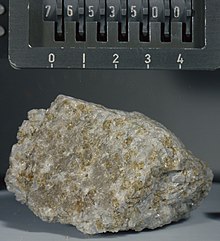Troctolite 76535

Troctolite 76535 is a
Taurus–Littrow valley. It has a mass of about 156 grams (5.5 oz) and is about 5 centimeters (2.0 in) across at its widest point. It was collected by geologist astronaut Harrison Schmitt as part of a "rake sample" of lunar soil at Geology Station 6, near the base of the North Massif.[1] Troctolite 76535 has been called the most interesting sample returned from the Moon.[2]
Description
cumulate at depth, thus possibly making the sample an important link in the understanding of the geologic timeline of the Moon.[6]
As Troctolite 76535 is the oldest known unshocked lunar rock, it has been used for thermochronological calculations in order to determine whether the Moon formed a metallic core or generated a core dynamo. The results of these studies have been shown to support the core dynamo hypothesis.[7]
References
- ^ "Lunar Sample 76535". Lunar and Planetary Institute, Lunar Sample Atlas. Retrieved 14 November 2014.
- ^ a b "76535 Troctolite" (PDF). National Aeronautics and Space Administration. Retrieved 26 October 2010.
- ISBN 978-0-08-020287-7.
- Bibcode:1999LPI....30.1308S.
- ^ Domeneghetti, M.C.; et al. (2001). "Complex Cooling Histories of Lunar Troctolite 76535 and Stillwater Orthopyroxenite SC-936" (PDF). Lunar and Planetary Science XXXII (2001). Retrieved 24 November 2010.
- .
- S2CID 23227936.

